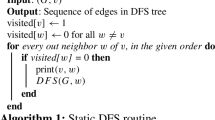Abstract
Abuaiadh and Kingston gave an efficient algorithm for the single source shortest path problem for a nearly acyclic graph with O(m+ n log t) computing time, where m and n are the numbers of edges and vertices of the given directed graph and t is the number of delete-min operations in the priority queue manipulation. They use the Fibonacci heap for the priority queue. If the graph is acyclic, we have t=0 and the time complexity becomes O(m+n) which is linear and optimal. They claim that if the graph is nearly acyclic, t is expected to be small and the algorithm runs fast. In the present paper, we take another definition of acyclicity. The degree of cyclicity cyc(G) of graph G is defined by the maximum cardinality of the strongly connected components of G. When cyc(G)=k is small, we can say the graph is nearly acyclic and we give an algorithm for the single source problem with O(m+n log k) time complexity. Finally we give a hybrid algorithm that incorporates the merits of the above two algorithms.
Preview
Unable to display preview. Download preview PDF.
Similar content being viewed by others
References
Abuaiadh, D. and J.H. Kingston, Are Fibonacci heaps optimal? ISAAC'94, LNCS, pp. 442–450 (1994).
Chaudhuri, S. and C.D. Zaroliagis, Shortest path queries in digraphs of small treewidth, Proc. of 22nd Inter. Colloq., ICALP95, Szeged, Hungary, July 1995, in Lecture Notes on Computer Science Vol. 944, pp. 244–255, Springer-Verlag (1995).
Dijkstra, E.W., A note on two problems in connection with graphs, Numer. Math. Vol. 1, pp. 269–271 (1959).
Floyd, R.W., Algorithm 97: Shortest path, CACM, Vol. 5, No., p. 345 (1962).
Frederickson, G.N., Fast algorithms for shortest paths in planar graphs, with applications, SIAM Jour. Comp., Vol. 16, No. 6, pp. 1004–1022 (1987).
Fredman, M.L. and R.E. Tarjan, Fibonacci heaps and their use in improved network optimization problems, JACM, Vol. 34, No. 3, pp. 596–615 (1987).
Moffat, A. and T. Takaoka, An all pairs shortest path algorithm with expected time O(n 2log n), SIAM Jour. Comp., Vol. 16, No. 6, pp. 1023–1031 (1987).
Tarjan, R.E., Depth first search and linear graph algorithms, SIAM Jour. Comp., Vol. 1, No. 2, pp. 146–160 (1972).
Tarjan, R.E., Data Structures and Network Algorithms, Regional Conference Series in Applied math. 44, 1983.
Author information
Authors and Affiliations
Editor information
Rights and permissions
Copyright information
© 1997 Springer-Verlag Berlin Heidelberg
About this paper
Cite this paper
Takaoka, T. (1997). Shortest path algorithms for nearly acyclic directed graphs. In: d'Amore, F., Franciosa, P.G., Marchetti-Spaccamela, A. (eds) Graph-Theoretic Concepts in Computer Science. WG 1996. Lecture Notes in Computer Science, vol 1197. Springer, Berlin, Heidelberg. https://doi.org/10.1007/3-540-62559-3_29
Download citation
DOI: https://doi.org/10.1007/3-540-62559-3_29
Published:
Publisher Name: Springer, Berlin, Heidelberg
Print ISBN: 978-3-540-62559-9
Online ISBN: 978-3-540-68072-7
eBook Packages: Springer Book Archive




